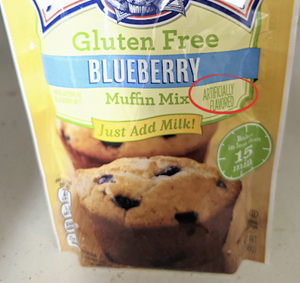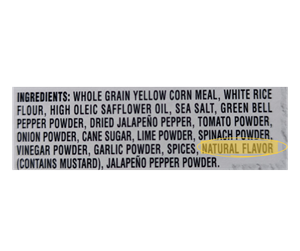Food should taste good. One of the best parts about eating is the taste. Flavors can come from natural food sources like fruits and herbs or can be extracted from foods and flavor can even be artificially created in a laboratory. "Natural" and artificial flavoring appear in most packaged products in the grocery store. When the word natural is on food packaging people are more likely to think positively about the product regardless of the rest of the ingredients (1).
What exactly does natural and artificial flavoring mean and where do these flavors come from? As consumers, it's so important to be informed of what to buy and how to decode what labels and products are at their core. At Simple Mills, we keep it simple and easy for you to decipher exactly what you are putting in your body, with nothing artificial, ever.
Let's break down the truth about natural flavors and find the benefits of using real, purposeful ingredients from whole foods to add flavor to products instead.
What are Artificial Flavors?
Artificial flavoring is any flavor that does not come from a natural source. These flavors are created in a laboratory by combining various chemicals to produce a desired taste or smell. Some common artificial flavors include
● Strawberry
● Cherry
● Chocolate
● Vanilla
● Grape
● Apple flavor
Products will indicate on the front of the packaging the flavoring such as blueberry and then in smaller print under the flavor will read "artificially flavored". In this example, the flavor is blueberry, and just to the right underneath the flavor, it shows that the flavor is coming from artificial sources.

The ingredient list on the back won't list the flavors that are used but will instead only state "artificial flavor” in most cases.
.png.aspx?width=300&height=251)
In this blueberry muffin mix example, the artificial flavoring used for the blueberry flavor also contains artificial dye and coloring to create the blueberry effect.
Better For You Alternative: use Simple Mills Banana Muffin & Bread Mix instead and add fresh blueberries. This option is just as quick and can offer a perfect blueberry muffin without adding artificial flavors or colorings to your muffins.
What are ‘Natural’ Flavors?
Natural Flavors are made up of a cocktail of chemicals. The Environmental Working Group has found that natural flavors are composed of over 100 structures. These can range from solvents to emulsifiers, flavor enhancers, and preservatives. Nearly 90% of natural flavors are made up of a combination of these. Making them not so "natural" at all.
Natural flavors come from natural sources, like fruits, vegetables, and spices. The FDA defines “natural flavors” as chemical flavor compounds extracted directly from plants, animals, or plants, and animal products as found in nature. If you have food preferences and are unsure where the natural flavoring is coming from it's best to call the manufacturer. These “natural” flavors can either be extracts or oils that have been distilled from the source material. In food manufacturing, it's rare that only one natural flavoring is used when "natural flavoring" is found on an ingredient list. Common natural flavoring can include:
● Lemon
● Orange
● Mint
● Cinnamon
● Clove
● Vanilla
● Anise
● Nutmeg
● Caramelized sugar (like the type used to flavor caramel) is also considered a natural flavoring.)
Products that use natural flavorings will show the flavor on the front like this example "Jalapeno & Lime" but then list the natural flavor listed below it.
.png.aspx?width=300&height=251)
On the ingredients list, it will state natural flavor and in this case, they added that one of the natural flavors contains mustard, but again there can be a large number of natural flavors used in one single product.

Better For You Alternative: use Simple Mills Almond Flour Crackers instead and choose the Cracked Black Pepper variety for a little bit of spice. Go from an unnamed amount of "natural" flavors to five herbs and spices that you likely have in your kitchen drawer.
Benefits of REAL Flavoring instead of Artificial and “Natural” Flavors:
-
You know exactly what you're eating: When you use whole foods to flavor your products, you know exactly what ingredients are going into them. This is beneficial for a number of reasons - you can be sure that you're not consuming any artificial or processed ingredients, and you can be confident in the nutritional value of the food you're eating.
-
Whole foods offer more health benefits: Not only are whole foods more natural and less processed, but they also offer more health benefits than their artificial counterparts. This is because they contain more vitamins, minerals, and antioxidants that are essential for good health.
-
Whole foods are more flavorful: In addition to being better for your health, whole foods are also more flavorful than artificial ingredients. You can’t beat the taste of fresh produce over artificially flavored foods! Foods made with whole ingredients tend to be more delicious and satisfying.
-
You can decide on the flavor of your food: When you use whole foods to flavor your food, you have a say in the taste. This means that you can tailor the flavor to your own personal preferences, and you don't have to rely on processed foods that may not taste as good.
-
Whole foods are environmentally friendly: Another benefit of using whole foods to flavor your products is that they are more environmentally friendly than artificial ingredients. This is because they require less energy and resources to produce.
Overall, choosing foods that have less artificial and "natural" flavoring can be more beneficial to your health. Likely choosing less of these foods will mean choosing more whole food and fewer processed food options which can lead to better health outcomes. When in doubt, choose products with shorter and more simple ingredient lists that you can easily identify. Simple Mills products are a great example of short ingredient lists packed with flavor. Excluding 100% of artificial and natural flavorings may not be the easiest so be gentle with yourself because no food is bad and eating should be fun!
We partnered with Rhyan Geiger, RDN, to break down natural and artificial flavors and explain the importance of real food ingredients in this post!